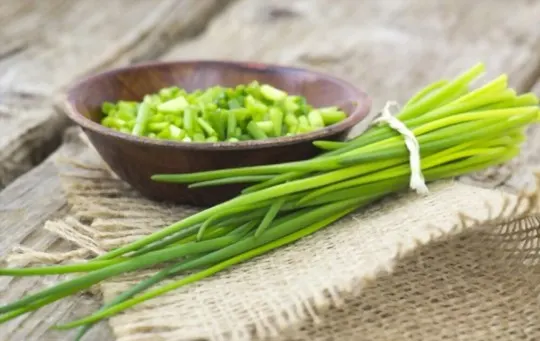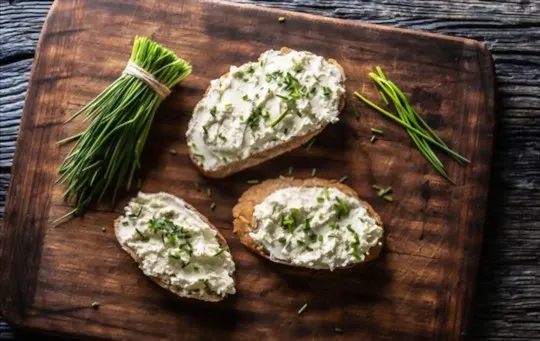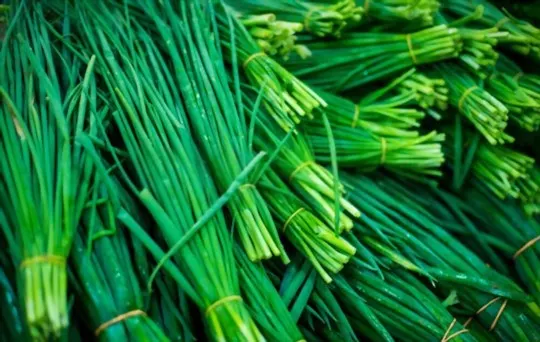Chives seem to not receive as much credit as spring onions or garlic despite being responsible for flavoring a wide variety of dishes.
So if you’re guilty of always attributing a delicious, chive-flavored meal to the wrong herb, here’s a quick guide to never get the flavors wrong.
The dark grass-like chives are a pantry essential and available in many variants.
So, what do chives taste like, and what exactly are they? We’ll look more into this fragrant herb below, so scroll on to learn everything about them.
What are Chives?

Chives are the long strands of delicate, bright green leaves of the Allium schoenoprasum plant.
The plant also produces small aromatic flowers in colors white, red, pink, and purple that varies depending on the variety.
While the entire chive plant is edible, they are primarily harvested for its leaves.
They are easy to grow and need very little maintenance.
Chives are predominantly consumed fresh as garnishes, but you can freeze them to flavor dishes when fresh ones aren’t available.
They are closely related to onions, leeks, garlic, and shallots but do not have an edible bulb at the bottom.
They are one of the most popular garnishes; the leaves add an herby touch to dishes, while the flowers add a pop of color and extra flavor.
Chinese chives, also called garlic chives, are wider, sturdier, and do not appear as bright as the common chives.
They are widely used in the cuisines of many Asian countries.
Apart from their culinary uses, chives add an ornamental appeal to gardens.
If planted in an artistic arrangement, its flowers will add a pleasant visual appeal to your garden when in bloom.
What Do Chives Taste Like?

Chives taste like a delicate mixture of green onions and garlic.
The leaves have a mellow and mildly tangy flavor without the spiciness of garlic.
However, the taste of blossoms aligns more with that of garlic.
Therefore, the leaves and flowers may find different uses depending on the flavor you are looking for.
But most often, you can use them together for a more diverse taste profile.
Despite having many similarities with green onions, chives have almost half the flavor potency.
So, if you used chives as a substitute for onions, you would need to add a considerable amount to achieve a similar flavor potency.
Fresh chives are mild and aromatic.
They have a delicate texture and are better used raw as a last step in any cooking process.
While you can add them in the midst of a cooking process, the heat seems to distort their flavor.
On the other hand, frozen chives are more concentrated in flavor and lack the aromatic properties prevalent in fresh ones.
So, they work better in soups and stews instead of garnishes.
The delicacy of chives may make it incapable of substituting green onions and garlic in every recipe because the latter two can withstand cooking to some extent.
However, Chinese chives may be your solution to attaining a replica of green onions that provide a similar flavor and have a more flexible cooking.
They are more versatile and suitable for fresh and raw or cooked use.
How to Serve Chives?

Chives are delicious when eaten raw, but they can attain perfection when you prepare them into a complex dish.
So here are our favorite ways to serve this fragrant herb:
- Sour cream dip: Everyone needs a cool and refreshing dip flavored with sour cream, lemon juice, and the pleasant aroma of fresh chives to beat the heat. It pairs exceptionally alongside chips and fried food like breaded meat. .
- Chimichurri sauce: Chives may not belong in traditional chimichurri recipes, but don’t let that stop you from enjoying its deliciousness. Chives bring a delightful blend of flavors to a regular chimichurri sauce, adding herbal and mellow accents.
- Pancakes: Plain pancakes are a breakfast favorite, but they can become quite boring when eaten repeatedly. So, flavor them with chopped pancakes to add a refreshing and herby touch to your everyday breakfast.
- Chive blossom cocktail: Wondering where you can best use chive flowers? Skip the regular food pairings and use them to flavor cocktails. Simply rinse the blossoms and add them to a gin and vermouth mixture, allowing the flavor to develop for a few hours.
Conclusion
Chives may be similar to onions and garlic in flavor, but they are noticeably different ; they have a lower potency in fragrance and taste.
Their leaves taste like green onions, while the flowers bear a garlicky flavor.
So , if you wish to maximize their flavor, consider saving fresh chives for the last step of the cooking process.
Now that you’ve had a head start to understanding the taste and texture of chives, all there’s left to do is try eating the herb yourself.
After all, no one, but you, can be a better judge of your palate.

What Do Chives Taste Like? Do They Taste Good?
Ingredients
- Chives
- Ingredients from your favorite recipes
Instructions
- Depending on the ingredients used, the cooking method, and the type of dish, the taste of the food can vary greatly.
- Make sure to select a recipe that will elevate the food’s original flavor, and enjoy experimenting with different recipes!

Andrew Gray is a seasoned food writer and blogger with a wealth of experience in the restaurant and catering industries. With a passion for all things delicious, Andrew has honed his culinary expertise through his work as a personal chef and caterer.
His love for food led him to venture into food writing, where he has contributed to various online publications, sharing his knowledge and insights on the culinary world. As the proud owner of AmericasRestaurant.com, Andrew covers a wide range of topics, including recipes, restaurant reviews, product recommendations, and culinary tips.
Through his website, he aims to inspire and educate fellow food enthusiasts, offering a comprehensive resource for all things food-related.

Leave a comment